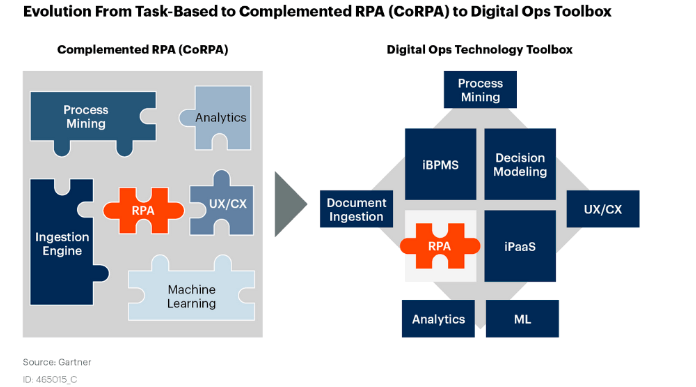Hyperautomation, a holistic approach to end-to-end process automation
by Saurabh Sharma, on Sep 7, 2020 1:13:27 AM
Gartner identified Hyperautomation* as the top trend in the list of Top 10 strategic technology trends for 2020. As enterprises look to exploit a broader set of automation tools to mitigate functional and process silos, there is a clear focus on achieving end-to-end process automation. Hyperautomation, as an automation approach leads to a solution architecture comprising a range of tools and capabilities, including but not limited to robotic process automation (RPA), intelligent business process management suites (iBPMS), integration PaaS (iPaaS), process mining, and business rules management systems (BRMSs) or Decision management suites (DMSs).
Low-code and configuration-driven, intuitive development and citizen user-friendly user experience (UX) are other key attributes of the components of hyperautomation.

Hyperautomation offers a solution architecture for enterprise process automation
Looking from a process perspective, hyperautomation signifies an evolution from task- or sub-process level automation towards end-to-end process automation. RPA has a role to play as a non-invasive approach to integration (or surface automation) used for automating routine, repetitive tasks. Intelligent document processing (IDP) solutions enable data ingestion into RPA tools for developing and executing intelligent automation workflows. IDP combines OCR, data capture, and AI/ML to automate the retrieval, understanding, and integration of documents required for executing a business process.
As per **Ovum, “a combination of an RPA platform and BPMS can significantly accelerate process automation”. RPA is a non-invasive approach to automation that does not require changes in legacy IT applications/systems. In terms of using an RPA platform and a BPMS in combination, specific sub-processes (tasks) of an end-to-end process can be automated via software robots and control can then be passed to the BPMS if there is a need for decision making (case management). The BPMS can provide a connector for integration with an RPA platform, enabling RPA involvement to be triggered from within the BPMS's workflow. Exceptions in the execution of sub-processes via RPA can be handled by the BPMS as an actionable activity. Process modelling and rationalization is a key requirement, as automating a sub-optimal process using RPA is unlikely to deliver much value.
iPaaS solutions are frequently used for on-premise-to-SaaS and SaaS-to-SaaS integration, and foster deep integration using APIs. Their core value proposition is faster time-to-value using a “drag and drop” approach, with pre-built connectors and integration templates enabling faster development of integration flows.
Using the data gathered from enterprise IT systems (e.g., event logs), process mining software extracts semantics on what happened and when in a process. This data is then turned into a visual workflow using algorithms. When combined with RPA, process mining tools can be used to automate routine sub-processes by discovering and analyzing individual processes, tasks, and their dependencies.
Focus on developing a holistic enterprise process automation strategy
Siloed approaches to automation can deliver only short-term gains, often fall short of delivering transformational business outcomes. RPA initiative leaders who do not spend enough time on analysis and optimization often think of RPA as a hammer and see most of the business processes as a nail to hit. This means that the automation of an inefficient business process with RPA is likely to deliver minimal gains.
Intelligent automation combines artificial intelligence (e.g., natural language processing, machine learning, and computer vision) with RPA and document capture and processing capabilities to tackle issues related to unstructured data. Without tackling the issues of unstructured data, it is difficult to achieve scale with process automation initiatives.
It is not uncommon to see enterprises struggling to achieve success owing to a fragmented strategy and a lack of a holistic vision for end-to-end process automation. Managing relationships with multiple automation tool vendors and professional services providers are itself a difficult task, not to mention that such an approach may lead to discrete objectives and islands of implementations that fail to scale beyond a few bots. Datamatics offers a comprehensive intelligent automation product suite, including TruBotrt, TruCap+, and TruAI. This is dedicated intellectual property (IP) built from the group up based on years of experience in delivering large-scale automation and data processing engagements.
A process-centric approach to robotic automation can overcome the limitations of traditional RPA products relying on user interface (UI) integration and can ensure a close alignment between the objectives for an RPA implementation and an enterprise's process automation strategy. In the end, the true value of RPA lies in its ability to function as an enabler to the automation of end-to-end processes (though not necessarily 100% automation) and not just mimic an end-user to perform specific tasks in a prescribed way. For larger implementations, enterprises must set up a center of excellence (COE) and have a proper governance framework in place to ensure that RPA initiatives remain on track and deliver business value.
Source: *Gartner, Move Beyond RPA to Deliver Hyperautomation, December 2019
** Ovum Decision Matrix: Selecting an RPA Platform, December 2018

















